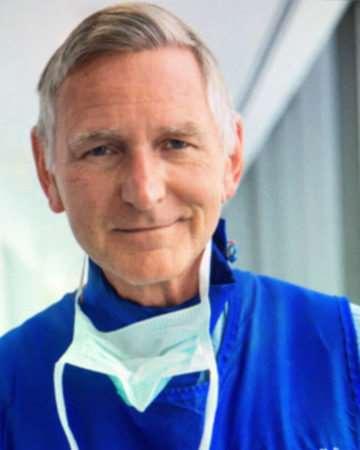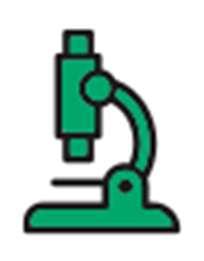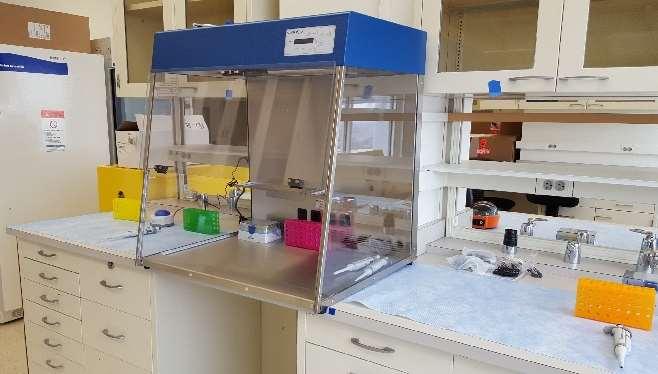

Reimagining Patient Outcomes with Regenerative Medicine
Upon the quick sting of a papercut or the sharp agony of a broken toe, the body’s natural healing process springs into action to repair damaged cells and tissues. But with major trauma like spinal cord injury (SCI) or substantial, progressive cell damage from diseases like multiple sclerosis (MS), there are limitations to the body’s natural course of recovery, leaving many individuals with permanent disabilities from these conditions.
Regenerative medicine seeks to mobilize the body’s innate restorative capabilities to heal traumatic injuries and prevent — or reverse — disabilities that, until very recently, were thought to be permanent. At RUSH University Medical Center, internationally regarded neurosurgeon RichardG.Fessler,MD, PhD, his research director BrianT.David,PhD, and their team within the Daniel F. and Ada L. Rice Laboratory for Regenerative Research are making groundbreaking discoveries in regenerative medicine, reimagining what’s possible for patients who have lost central nervous system function. The team is producing never-before-seen results in treating SCI with hopes that these promising advancements can soon be harnessed to treat other areas of disease and disability.
“This is really the first time in history that we’re making visible progress. Continued research could propel life-changing improvements to people’s mobility, independence and overall lives. We’repushingtheboundariesof whatmedicinethoughtwaspossiblebyexploringtheregenerative possibilitiesofthenervoussystem.”
— Richard G. Fessler, MD, PhD Professor of neurosurgery and director of the DanielF. and
Ada L. Rice Laboratory for Regenerative ResearchAchieving Previously Unimaginable Progress

Dr. Fessler’s commitment to regenerative medicine research over the past 26 years — especially since initiating clinical trials in humans in the past 11 years — has led to revolutionary medical advances. Our studieshaveenabled peoplewithcertaintypesofSCIwhopreviouslyhadlittletonomobilityto conductmanydailyactivitiesindependently, like eating, drinking and toothbrushing. Dr. Fessler and his team have been key players in advancing the study of LCTOPC1 (formerly AST-OPC1) cells responsible for this life-changing development.
By applying the power of these stem cells at the injury site in the immediate aftermath of an injury, scientists can help patients experiencing certain types of SCI efficiently regenerate myelin — a layer of insulation in the central nervous system that enables nerve cells to communicate messages between the brain and body. RUSH scientists are using this momentum to propel further regenerative medicine research to benefit more patients with SCI and other conditions where the potential for stem cell therapies remains largely untapped.
Perfecting Methodologies Through Bench-to-Bedside Research
Informed by the challenges and opportunities Dr. Fessler observes daily in the clinic and operating room, the Daniel F. and Ada L. Rice Laboratory for Regenerative Research conducts studies researchers believe will directly influence patient care. This kind of translational science is called bench-to-bedside research, depicted in the graphic below.
Clinic

Research advances treatments and improves patient outcomes


Lab
The laboratory is leading multiple initiatives to this end:

Patient outcomes and experiences inform questions that require research to answer
MakingstemcelltreatmentsviableformorepeoplewithSCIthrough3Dprinting
For most people who endure an SCI, cigar-shaped cysts develop at the injury site, preventing stem cells from accessing the tissue they need to grow within the spinal cord. To make stem cell treatments more effective for patients with these cysts, Dr. Fessler and his colleagues are creating custom-made, 3D-printed matrices infused with stem cells that can be implanted into the spinal cord. These matrices act as scaffolds that provide a more hospitable environment for transplanted cells to grow. Researchers showed, in proof-of-principle experiments, that multiple injectable 3Dprinted biomaterial scaffolds could successfully be implanted into animals with spinal cord injuries without increasing inflammation while enhancing the survival of transplanted stem cells.
Improvingthedeliveryofstemcellsintothespinalcord
To determine best practices for administering LCTOPC1 cells, scientists are investigating a new technique of delivery, injecting the cells using a frame that attaches to the spine to account for the motion of a patient’s respirations. They are also analyzing the best post-injury timing for the administration of stem cells to optimize results.
Minimizingthebody’sinflammatoryresponsefor moreeffectivestemcelltransplantation
Dr. Fessler’s studies have made it clear that stem cell treatments can result in transformational outcomes for some patients with SCI — but the timing is everything. For stem cells to be effective and survive attacks from the immune system, inflammation (the body’s natural response to injury) in the spinal cord needs to be reduced to the greatest extent possible. Scientists in the laboratory are developing an injectable anti-inflammatory compound that can be used in a field of war or at community hospitals directly following an SCI to prevent a damaging inflammatory response before the patient can be safely transferred to a major medical center like RUSH for stem cell transplantation. This data has enabled researchers to apply for U.S. Department of Defense grants.

InvestigatingtheinfluenceofthegutoninflammationandoutcomesafterSCI
In many fields across medicine, promising research is being conducted on the influence of the bacterial makeup of the digestive system, or the gut microbiome, on health. At RUSH, regenerative medicine researchers have come to understand that an SCI changes the gut’s bacterial makeup, which may influence the duration of inflammation a person experiences following injury. To further investigate this idea, RUSH researchers are performing advanced analyses on the feces and cecums (a pouch connecting the small and large intestines) collected from rodents in the lab’s preclinical studies following stem cell transplantation. Partnering with the RUSH University Genomics and Microbiome Core Facility, the team is looking for distinct markers of inflammation that could be targeted with therapeutics. Data from initial studies revealed that interventions targeting the gut improved neuronal recovery at the SCI site.
Studyingnewtreatmentsforpainful,debilitatingsymptomsofdemyelinatingdiseases
Limited mobility may be the symptom most associated with demyelinating conditions like SCI and MS, but patients with these diagnoses often experience additional symptoms that profoundly disrupt their quality of life. Our experts are working to develop better treatments for symptoms like pain and bladder dysfunction through experiments focused on chronic non-resolving inflammation (thought to be a driving factor of both symptoms in animal models). One of our lab’s doctoral students spearheaded efforts to characterize acute biomarkers (like blood pressure, heart rate and cytokines in blood) of chronic neuropathic pain, or CNP, following SCI, with an eye toward administering preemptive treatments that could prevent CNP’s development. This kind of pain is experienced by roughly half of people who endure an SCI. Results of preclinical tests are expected soon, which could support new techniques for measuring and potentially targeting CNP after SCI. A graduate student also defended his master’s thesis to clarify the relative roles of inflammation and immobilization on bone loss following SCI — a project still being pursued in the lab.
Our Next Frontiers in Research
To build upon the exciting advancements being made in regenerative medicine, Dr. Fessler and his team are optimistically planning the next stages of research to improve patient care. The team intends to:
AdvanceresearchthatsetsthestageforLCTOPC1 stemcelltransplantationtobethenewstandard ofcareinSCItreatments
To fully take an experimental treatment from bench to bedside, researchers must sufficiently prove its safety and efficacy in a rigorous series of human trials overseen by the FDA. These trials have exceeded expectations to date, and now Dr. Fessler and his collaborators are in discussions to advance their study of LCTOPC1 cells into a randomized controlled trial. This type of study design, which will evaluate stem cell transplantation against a closely matched placebo intervention, is considered the “gold standard” study required before an intervention can receive FDA approval.

AmplifythestudyofstemcellsforthetreatmentofdemyelinatingdiseaseslikeMS
Thanks to the acquisition of a new irradiator, a critical new tool for biomedical research in our labs, Dr. Fessler’s team can now proceed with basic science studies in animal models to investigate the use of stem cells for the treatment of demyelinating diseases like MS and ALS. The irradiator will allow scientists to initiate demyelination in animals and override the natural remyelination process to test cell transplantation for the treatment of MS. Our researchers partnered with RUSH Radiation Oncology team members to begin using the irradiator in experiments to test various cell transplantation strategies for their ability to remyelinate lesions.
BuilduponacuteSCIresearchtotranslate findingstothetreatmentofchronicSCI
The promise and remarkable results stem cell treatments have shown in treating acute SCI have improved patients’ lives. Currently, these treatments have only proven successful in the weeks immediately following the injury.

Researchers are beginning preliminary studies to evaluate how regenerative medicine could be applied to improve outcomes for those with subacute SCI (12-18 months post-injury) and the more than 250,000 Americans living with chronic SCI, or those who experienced an injury in the past and have been living with resulting disabilities for some time.
Our experts will soon conduct a round of biomaterials and microbiome experiments in an effort to enhance cell survival in animals that receive stem cell transplantation at the subacute stage. A doctoral student led a study to characterize the role of regulatory T-cells (a component of the inflammatory response) in the spinal cord after injury (both acutely and chronically). Researchers hope to understand when regulatory T-cell activity peaks following injury to find the best window of time to reduce inflammation and determine the viability of treatment for patients with chronic SCI. Preliminary results will be submitted for publication soon.
Help RUSH Researchers Advance Possibilities for Patients
RUSH scientists are making profound advancements in regenerative medicine research, but none of these developments would be possible without philanthropy. Donor support enables scientists to acquire essential equipment and employ personnel needed to conduct proof-of-concept research with which they can apply for federal funding and grants. This brings promising discoveries closer to human trials and, ultimately, improved treatment options for all.
Your support will enable researchers to build on this exciting progress to bring regenerative treatments to scale. As Dr. Fessler said, “Donors enable us to do this research, meaning theyaredirectlyresponsible fortheadvancementswearemaking.”

To make a gift or learn more about supporting regenerative medicine care and research at RUSH, contact:
BrigidMullen
Executive Director of Development (312) 942-4460 brigid_t_mullen@rush.edu
